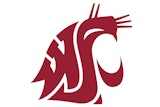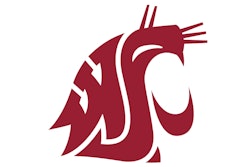
Hardwood ripples. Free-throw lanes rise. Game footage rolls and championship banners unfurl in an unexpected space — the playing surface. Welcome to the next generation of in-arena entertainment.
Rather than relying strictly on video and ribbon boards, several teams have turned to companies like Quince Imaging to convert their entire playing surface into a three-dimensional, jaw-dropping highlight display. As an example, check out this video from a March 8th Cleveland Cavaliers pregame show honoring the jersey retirement of Zydrunas Ilgauskas.
Cleveland’s show isn’t the first of its kind. The Kentucky Wildcats, Brooklyn Nets and Miami Heat are among several basketball teams to have entertained fans with this technology. So how does one go about turning a basketball court into a high-definition, 3-D display? Why don’t more teams do it? Can it be done on ice and turf?
For answers, AB turned to Scott Williams, co-founder and COO of Quince Imaging, the company that pulled off the productions for the Cavaliers and Heat.
RELATED: Q&A with Quince Imaging's Scott Williams
First of all, what you’re seeing in the Cleveland and Miami examples isn’t magic. And it is not some sort of video surface rolled out on top of the floor. It’s a very bright, high-quality projection coming from 12 of the highest-powered projectors money can buy. Williams calls his work “the science of display.”
Step One: Scope Out The Scene
About 60 days before fans are wowed by the final product, Williams and his team will survey the arena and figure out where they are going to install their high-powered projectors. The projectors weigh about 200 pounds apiece and are typically installed in the arena’s rafters. According to Williams, they retail for nearly six figures, so getting this right is important.
The show in Cleveland used 12 projectors. Some productions can get by with just eight, depending on ambient light and the complexity of the show. “If you are going to go completely dark and not use the center scoreboard, you can get away with eight,” Williams says. “That’s the bare minimum.”
For Williams, a 33-year veteran of the projection imaging industry (he started his career projecting maps and displays used by the U.S. military), his business is all about controlling and producing the perfect amount of light.
“There are two things that have to happen,” Williams says. “Number one, the projection has to be bright as heck. Secondly, you have to be able to control ambient light. Ambient light is a showstopper.”
From there, Quince Imaging builds a 3-D CAD model of the court and works with the team’s video or media department on the production’s content.
“We’re really the specialists in the 3-D aspects, the shimmies and shakes of the court, some of those advanced things like you saw with the Cleveland production,” Williams says. “But the highlight reels and the sizzle reels, those are the forte of the arena’s media folks and usually we work with them to ingest that content into the piece.”
Once the content is lined up, it’s time to process the video, known as rendering. And with such large media files, the rendering process can take up to four days. “There’s no stopping it once you start, so you’ve got to have it right,” Williams says.
Step Two: The Install
A few days before the game or event, the Quince team will arrive at the arena to install and test their projectors.
“It’s not hard for somebody to point a projector at something,” Williams says. “But to get it right requires a fair amount of science and expertise. You wouldn’t want someone to learning how to do this at your event.”
The setup usually occurs in the middle of the night when the arenas are completely empty. “Some of these arenas have very busy schedules with concerts or hockey games and events, so there’s not really a great time to come in and set up,” Williams says. “For the Miami Heat installation, we came in and did that one the night before the game. But by this time we know exactly where everything is going to go, it’s just a matter of setting it up and running through the tests.”
Step Three: Showtime
By game time, actually pulling off the show is the easy part. With the media already created and everything tested, the operator presses “play,” and the show begins.
Application of this technology isn’t limited to basketball courts. Ice, grass, turf, even the side of a city building can all be turned into projection screens.
“Now, the lighter the color of the surface is, the better,” Williams says. “A football field is more of a challenge, but it’s certainly not something you can’t overcome.”
Then there’s the million-dollar question. Literally. There are a lot of costs involved to pull this off. In Quince Imaging’s business model, the customer pays Quince to rent the equipment involved. Each projector retails for $85,000-$90,000. Then there are the fiberoptic cables and media servers required to support the content. A typical show requires at least two servers, each costing about $75,000. Then there is the time required from Williams and his team. He says Cleveland’s show required about 500 hours of work.
While we couldn’t squeeze an exact price quote out of Williams, he did say this:
“The prices [on projection technology] continue to come down. And I know some teams spend up to $1,000,000 on lighting and special effects in their arenas and for about the same price, they could have something like this — so that gives you some clue as to the cost.”
For sports venues, Quince Imaging has mostly just done one-time productions. “A playoff series or something like that would be a good opportunity to do it on multiple occasions, but for the most part, these are one-time things right now,” Williams says.
He adds that the cost is scalable. Some jobs are more expensive than others. “The price for our applications is driven mostly by two factors: the image area and ambient conditions,” Williams says. “Once these two factors are determined, we can arrive at a brightness and pixel density needed for virtually any application, whether it be a special event or commercial television.”
Meanwhile, Quince Imaging is continuing to innovate. They’re working on interactive media displays that react to motion. Imagine a trail of flames following LeBron James as he takes the court during Heat pregame introductions.
Video boards will always be a vital part of the fan experience in sporting venues. But companies like Quince Imaging believe the biggest video board in every stadium isn’t a video board at all.





































